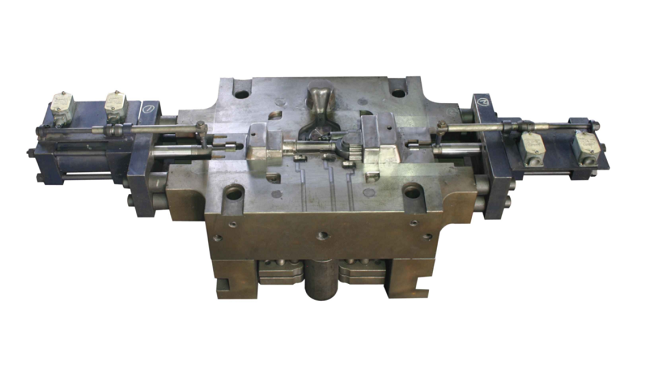How To Prevent The Fracture Failure Of Die Casting Mold
Damage is the most serious failure form of die casting mold. This guide introduces the common failure forms of die casting mold operation events, analyzes the causes of failures, and discusses the technical methods to reduce and avoid various failures. It can be used as a reference for solving similar problems in production practice.

Fracture Type Of Mold Working Parts
The fracture of die casting mold working parts has various shapes. According to the nature of fracture, it is divided into brittle fracture and plastic fracture. According to the fracture mechanism, it is divided into primary fracture and fatigue fracture. Here, the fracture occurred in the process of mold manufacturing is analyzed.
There are seven common fracture types in mold manufacturing, among which quenching cracks are the most. According to the shape of parts, the specification of quenching and heating, cooling conditions and processing conditions, quenching occurs in many forms. It is only necessary to carefully and accurately analyze the quenching process and the shape and material of part structure. Reasonable and effective methods and countermeasures can be formulated.
How To Prevent Mold Fracture
1. Methods to prevent quenching cracks
(1) Reasonably design the shape of parts
Equal wall thickness design shall be adopted as far as possible to avoid sudden variation of cross-section shape: ① do not integrate the parts with large wall thickness difference. In order to make the strength of each block equal as much as possible, block structure must be adopted. ② Large parts must be of hollow structure as far as possible. ③ Holes shall be opened as required to avoid acute angles at the corners of the four contours. Try to increase the large corner radius r, and the fillet radius of Liu tool steel heat treated parts must be less than 2 mm.
(2) Strictly control the heat treatment process
Formulate correct heat treatment technical specifications according to the size, shape characteristics and material of parts, and reasonably select heating speed, temperature and time. ② Adopt complete temperature control measures, master the actual temperature of components in real time, and check the temperature control device regularly.
2. Methods to prevent ignition cracks
Tempering crack refers to that the martensite structure of quenched steel is in an expanded state. During tempering, it first shrinks at about 10 ℃. At this time, if the quenched part is heated rapidly, the surface of the part shrinks and the interior becomes an expanded state, causing cracking.
The measure to prevent such cracking is not to conduct rapid heating before the component is heated to 30 ℃. Tempering cracks also occur in tempering cooling because the residual austenite in the quenched structure is rapidly cooled and becomes the same state as quenching. The method to prevent this cracking is air cooling from the tempering temperature.
3. Methods to prevent spontaneous cracking
Because the surface structure of quenched parts is residual austenite, if austenite changes into martensite at room temperature, transformation expansion and cracking of parts will occur. The countermeasure to prevent such cracking is to temper the parts immediately after quenching. It’s best not to exceed 3 hours. If tempering is not possible on the same day, put the parts into a 10 ℃ furnace or water for thermal insulation, and conduct formal tempering the next day.
4. Grinding crack countermeasures
Grinding crack is mainly caused by grinding heat, which is the same as tempering crack. It is the crack caused by grinding heat making the quenched structure of the surface shrink with fire. The direction of crack generation is generally at right angles to the grinding direction.
The countermeasures are as follows: Before grinding quenched parts, conduct low-temperature tempering at 150 ℃ or high-temperature tempering at about 30 ℃ (when the grinding amount is large). Strictly trim the grinding wheel to maintain the sharpness of the grinding tool. In order to reduce grinding heat, strictly prevent grinding wheel blockage; Reasonable selection of gear particle size proves that selecting coarse sand particle size in processing practice can reduce the occurrence of cracks. Select the appropriate grinding amount to increase the gear speed and the speed of parts at the same time.
5. Decarburization cracking prevention method
The reason for decarburization is that the heating temperature is too high, or proper protection cannot be carried out when heating in air. Therefore, to prevent decarburization, the workpiece can be heated in the vacuum furnace, or the temperature of the well heated by the components can be strictly adjusted in the protective environment.
6. Low temperature crack countermeasures
As the residual stress of quenching increases during cold treatment, low-temperature cracking occurs. Therefore, low-temperature tempering process needs to be added before cold treatment to reduce the occurrence of cracking.
7. Anti cracking countermeasures for EDM
The instantaneous high temperature and rapid cooling of EDM are easy to form microcracks on the surface of quenched parts. The prevention method is to use small gauge machining (affected by machining speed), or carry out the grinding treatment required for the metamorphic layer after machining.

